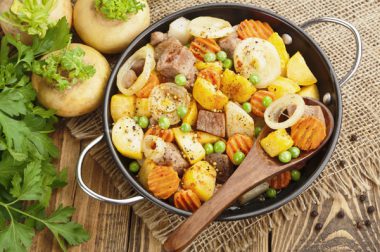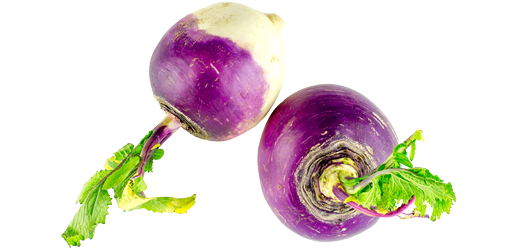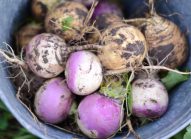Recipes we love
See all recipesMilan-style turnip gratin
Ideal as an accompaniment to grilled red meats. Use the poultry stock to get an even more tasty reci...
Health
benefits
Be a turnip leaf lover!
Turnip tops (leaves) are a good source of provitamin A and vitamin B9, an important nutrient for pregnant women. They are also a good source of vitamins C and E and add flavor to both blended and brothy soups.
Turnips are also:
- a source of potassium (for the nervous system, muscular function, and blood pressure)
- a source of vitamin C (for immune and nervous system health, collagen formation, energy, fatigue reduction, and iron absorption)
They also contain:
- fiber
- provitamin A or beta-carotene
- glucosinolates, compounds with anticancer properties
Nutritional
composition
When is the right
time to eat them?
Fall, winter, and spring.
Their high season lasts from October to May. However, they are available year-round.
Vegetable patch or
urban balcony?
Turnips are annuals that grow well in full sun, in cool soil rich in humus. Turnips need a temperate, mild, and humid climate to develop optimally.
To learn everything you need to know about growing turnips, read the page on growing advice.
Choosing and
storing turnips
Choose your turnips well:
- The color of turnips (white and pink) should be bright and without spots.
- Choose small turnips, which will be less hard and more flavorful.
- Turnips have a characteristic smell, but it should not be too spicy.
- Fresh turnips have vigorous, green tops.
Properly store your turnips:
- Turnip leaves are delicate, so eat them as soon as possible if you are keeping them.
- In the refrigerator: Four to five days in the vegetable drawer for the turnips, one to two days for the tops.
Tips and
tricks
How to prepare turnips
First, remove any remaining roots and the base of the leaves. Next, you should usually peel them, unless they are new turnips.
Cooking times:
- 5 min: blanched
- 25 min: boiled
- 10 min: in the pressure cooker or microwave
- 10 min: sautéed in a pan or a wok
- 30 min: roasted in the oven
Turnips go well with…
Raw: Grated, turnips can be paired with many other raw vegetables in salads (lettuce, green peas, endive, beets, and more). Spring turnips, which are delicate in taste, will work better in this preparation than winter turnips, with a stronger flavor.
Cooked: Turnips are the key vegetable in pot au feu, vegetable stews (with carrots, parsnips, mushrooms, etc.), and lamb navarin. They pair well with pork and salmon, dried fruits, poultry, and cheese. They also lend a surprising taste to couscous and tajines.
Finally, turnips are great mashed with potatoes and make wonderful creams and blended soups…and even fries!
Did you know? Who would have thought that turnips were so rich in vitamin C? That is why it is beneficial to eat small, barely cooked turnips that are still crunchy. They are commonly mixed with carrots, which provide you with an excellent serving of vitamin C and provitamin A.
Can everyone
eat them?

Young children
Children can eat them starting at age 12 months. The bitterness of turnips can be softened by adding a small amount of sugar to the preparation, or potatoes, if you are making a puree.
And everyone else
Some people with irritable bowel syndrome may experience digestive discomfort when they eat turnips. When symptoms are light, or during remission, it is still possible to progressively reintroduce turnips to take advantage of their nutritional benefits.
See plenty of other tips for encouraging children to eat vegetables
Where do they come from?
Origins and varieties
Origins: Native to Europe (the United Kingdom, France, Italy, and Ireland), turnips are an ancient vegetable that was grown long before the arrival of the potato. Turnips were one of the vegetables eaten on a near-daily basis. While today they are not eaten as much in Europe, they are still cultivated.
Varieties: The fleshy root of the turnip has a color that differs according to the variety, with shades that include white, pink, and salmon. There are over 30 species of turnips, the most well-known of which, the Purple Top Milan, has a flattened, round shape and can be recognized by its white skin with a purple ring. The Nancy and Norfolk turnips are very round, while the Nantais and Croissy turnips are longer and white. The Jaune Boule d’Or is a very rare variety, with yellow flesh that is tender, fine-textured, and lightly sweet.
Fall turnips are grown more often in Nordic regions, while spring turnips are the most common today.
Don’t mix turnips up with rutabagas! Rutabagas, a cross between a cabbage and a turnip, are distinguished by their uniformly yellow flesh and the more beige color of their skin.



 Radishes
Radishes  Sorrel
Sorrel  Vegetable garden: growing broad bean
Vegetable garden: growing broad bean 










